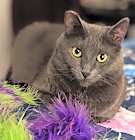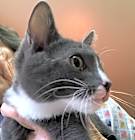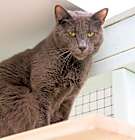Nope, Russian Blue cats have short, dense fur, according to the Cat Fancier’s Association. But a related breed, the Nebelung cat, is sometimes mistaken for a long-haired Russian Blue, and it's easy to see why. The fluffy Nebelung breed was derived from a Russian Blue crossbreeding.
Russian Blue
Breed Type: Western
Common nicknames: Archangel Cat, Archangel Blue
Coat: Short-haired
Hypoallergenic: Yes, they may not trigger allergies.
Temperament: Affectionate, reserved, gentle, adaptable
Life expectancy: 15-20 years
Color & patterns: Blue

With a sleek, shimmering blue coat, striking green eyes, and a lineage stretching back to the ports of Arkhangelsk in Russia, Russian Blue cats have won hearts worldwide with their mesmerizing beauty. But these cats aren’t just stunning to look at; they’re also witty, intelligent, and have a playful streak that’ll keep you endlessly entertained. Don’t be surprised to find your Russian Blue fetching toys like a dog or masteringpuzzle feeders in no time — they’re that smart. With a gentle and affectionate nature, they make great family pets and are particularly good with children and other pets. They’re also perfectly content with some quiet time and being the dignified observers of your household drama. So, if you’re in search of a cat with royal charm, a brilliant mind, and a heart full of love, the Russian Blue might just be your perfect match.
Russian Blue characteristics
Learn about about Russian Blue basics like their fur colors, shedding levels, how much grooming they need, and other Russian Blue facts.
Average height
10-12 inches (25.4-30.5cm)
Average weight
7-15 pounds (3.2-6.8 kg)
Average lifespan
15-20 years
Good with other cats
Good with dogs
Affection
Shedding
Health
Exercise needs
Can Russian Blue cats have blue eyes?
According to several cat association standards, the Russian Blue breed must have a vivid green eye color. Many Russian Blue kitties are born with yellow eyes that slowly transition to their mature adult green color. Around four months of age is when pet parents often begin to notice the ring of green coloring. But genetics can be tricky. A small percentage of cats may have an eye color that leans more blue or more orange, and that’s okay. It’s possible a Russian Blue cat may have blue eyes. While the cat may be disqualified from breed showings, they’ll still be a great pet.
How big do Russian Blues get?
Russian Blues weigh between seven to 12 pounds and stand around eight to 10 inches at the shoulder. Their graceful, slender build and sleek physique give them an elegant appearance. Although they might not be as hefty as some larger cat breeds, their muscular and slender bodies are still sturdy and agile.
What color coat does a Russian Blue have?
Russian Blue cats have a blue-gray coat, which is dense, short, and plush, often described as a silvery blue. This distinct blue-gray fur coat color arises as a diluted expression of the black color gene.
What eye colors can a Russian Blue have?
Russian Blue kittens typically have yellowish eyes with green edges, which eventually transform into bright, vivid green eyes as they reach adulthood. This distinctive eye coloration sets them apart, transitioning from a yellow-green shade in their early months to the emerald green that is a hallmark of the Russian Blue breed.
Are Russian Blue cats polydactyl?
No, Russian Blue cats are not typically polydactyl, meaning they do not possess extra toes beyond the normal count. They have the standard number of toes, usually five on each front paw and four on each back paw. While this breed is not known for being polydactyl, the mutation can spontaneously occur in any cat breed.
Does a Russian Blue cat shed?
Yes, Russian Blue cats shed, but very minimally. They are considered a low-shedding breed, making them a great choice for individuals who prefer cats who shed less. However, like most animals, they do shed a small amount of hair. Regular grooming can help reduce shedding and keep their coat in good condition.
What type of coat do Russian Blue cats have?
Russian Blue cats have a short, plush, and double-layered coat. Their soft fur is dense and lies close to the body, creating a shimmering effect. This double coat consists of a soft and downy undercoat covered by longer guard hairs, producing a sleek, dense, and fine-textured coat.
What is the lifespan of a Russian Blue cat?
Russian Blue cats have an average lifespan of around 15 years, but with proper care and a healthy lifestyle, they can live into their late teens or early twenties. Good nutrition, regular veterinary check-ups, a stress-free environment, and plenty of affection and exercise contribute to their longevity.
When do Russian Blue cats stop growing?
Russian Blue cats stop growing around one year. The first year of their life is marked by a steady development in terms of both size and behavior. However, their growth rate generally slows down after the initial year, and they reach their adult size and weight by 18 months.
Are Russian Blue cats hypoallergenic?
Yes, Russian Blue cats are often considered hypoallergenic due to their shorter fur and lower production of the Fel d 1 protein, a common allergen in cats. While no cat is completely hypoallergenic, some individuals with cat allergies might find Russian Blues cause fewer allergic reactions compared to other breeds, but this can vary from person to person. Regular grooming and maintaining a clean environment can also help reduce allergens and their potential to trigger allergic responses.
How many types of Russian Blue pedigrees are there?
Russian Blue cats have three distinct lines in their pedigrees, primarily the American, British, and Scandinavian types. These lines highlight noticeable differences.
The American type, which is currently popular, tends to be smaller and lighter in color, featuring larger, rounder eyes.
The British type stands out for its intensely emerald-colored eyes, with a larger, heavier body structure and vertically placed ears.
The Scandinavian type serves as an intermediary, combining qualities from both the American and British lines.
Russian Blue temperament
Learn about about the Russian Blue temperament and how well they fit into your lifestyle, home environment, and family.
Do Russian Blue cats like to be held?
Russian Blue cats do like to be held — but it really depends on the cat and the moment. While breed traits do influence a cat’s personality, they play a minor role compared to other factors such as individual personality and past experiences. This means that while many Blues are snuggly and ready for a hug, others might prefer to keep all four paws on the ground.
Are Russian Blue cats good lap-cats?
Yes, Russian Blue cats can make good lap-cats. They are known for their affectionate nature and often enjoy curling up on the laps of their pet parents. At the same time, the Russian Blue isn’t an overly clingy cat breed.
Are Russian Blue cats good with dogs?
Yes, Russian Blue cats are known to be good with dogs, particularly when introduced and socialized properly. Their gentle and amiable nature often allows them to form positive relationships with dogs. The key to successful cohabitation lies in gradual introductions and supervised interactions.
How affectionate are Russian Blue cats?
Russian Blues are affectionate with their pet parents, but usually skittish or avoidant around strangers. While not overtly demonstrative, they are known to show affection by seeking out the company of their favorite humans and enjoying cuddles and lap time. Ultimately, Russian Blue cats are recognized for their reserved yet affectionate nature.
Are Russian Blue cats good hunters?
Yes, Russian Blue cats are good hunters and often demonstrate their hunting instincts by chasing and catching prey. Their inclination towards hunting is an inherent trait, stemming from their agile and athletic nature. These cats exhibit excellent hunting skills and can often be found stalking and pouncing on various toys or objects.
How vocal are Russian Blue cats?
Russian Blues are not very vocal or talkative cats. Although they are not entirely silent, they are typically less talkative compared to some other breeds. While they might occasionally communicate through gentle, melodious sounds, their voices are often considered softer and less frequent, making them a less vocal breed compared to many other cat breeds.
Are Russian Blue cats good indoor cats?
Yes, Russian Blue cats are good indoor cats and thrive in household settings due to their calm and reserved temperament. These felines enjoy the security of indoor living and tend to form strong bonds with their human companions. Their adaptability to confined spaces and their serene nature make them content indoor pets, provided they have opportunities for play, mental stimulation, and interaction with their pet parents.
Are Russian Blue cats good with other cats?
Yes, Russian Blue cats are typically good with other cats given their friendly and non-confrontational nature. They often enjoy having feline company and can form strong bonds with other cats in the household. Proper introductions and socialization can help them establish positive relationships with other cats.
Russian Blue health
Learn about about the Russian Blue health outlook and what diseases they may be prone to at various stages of their life.
Do you need to groom a Russian Blue cat?
Yes, you need to groom a Russian Blue cat. Grooming a Russian Blue is relatively straightforward due to their short, dense coat. They are low shedders and typically self-groom, requiring minimal grooming maintenance. A weekly brush with a soft bristle brush helps remove loose hair and redistributes skin oils to keep the Russian Blue’s coat healthy and shiny. Regular nail trimming, teeth brushing, and routine ear checks are also important to ensure overall hygiene and health.
Do Russian Blue cats like milk?
While cats have a reputation for enjoying milk, it isn’t recommended by veterinarians. Russian Blues can be lactose intolerant, meaning they lack the enzyme required to properly digest the lactose in milk, which can lead to digestive issues like diarrhea or an upset stomach. It’s safer to offer fresh water as the primary source of hydration for your Russian Blue.
What do Russian Blue cats eat?
Russian Blue cats thrive on a balanced diet consisting of high-quality cat food, whether it’s commercial dry kibble, wet food, or a combination. It’s essential to ensure their diet includes the right balance of protein, fat, and other nutrients, as well as plenty of fresh water. Consult a veterinarian to determine the best diet for your Russian Blue.
Do Russian Blue cats eat wet food?
Yes, Russian blue cats eat wet food. Wet food can provide hydration and variation in their meal routine, but it’s important to select high-quality wet cat food that aligns with their nutritional needs. Whether you choose wet or dry food, ensure that it is nutritionally balanced and meets your cat’s dietary needs.
Do Russian Blue cats have health issues?
Yes, Russian Blue cats can have health issues but are considered a healthy breed. Health issues they might face include:
Gingivitis: This is inflammation of the gums, which can lead to periodontal disease.
Heart conditions: Some Russian Blues might be susceptible to genetic heart conditions like hypertrophic cardiomyopathy (HCM), a heart condition characterized by the thickening of the heart muscles, which can affect the heart’s ability to function properly.
Obesity: Russian Blues have a hearty appetite and are prone to obesity. It is best to give them scheduled feeds and minimal treats.
What diseases are Russian Blues prone to?
Russian Blue cats are prone to gingivitis, obesity, and hypertrophic cardiomyopathy (HCM), although they’re considered a relatively healthy breed. Responsible breeding practices and regular veterinary check-ups are crucial to monitor and manage any health concerns these cats may have.
Russian Blue history
Learn about where this Russian Blue came from!
Where are Russian Blue cats from?
Russian Blue cats are believed to originate from Russia, as their name implies. Their history traces back to the port of Arkhangelsk on the White Sea, where sailors brought these cats from Archangel, a northern Russian city. The breed was first exhibited in England in the late 19th century and has become a well-known and popular breed around the world.
Find Russian Blue kittens near you
Adopting a Russian Blue
Learn about acquiring a Russian Blue - the pros and cons of adopting versus going through a breeder, and associated costs.

Gidge
Russian Blue
Female, 11 mos
Studio City, CA
Not good with dogs
Not good with cats
Spayed or Neutered
Shots are up-to-date

Alice
Russian Blue
Female, 3 yrs 1 mo
Sherman Oaks, CA
Not good with dogs
Good with cats
Spayed or Neutered
Shots are up-to-date

Theo
Russian Blue
Male, 7 mos
Los Angeles, CA
Not good with dogs
Good with cats
Shots are up-to-date

Maude
Russian Blue
Female, 2 yrs 2 mos
Los Angeles, CA
Not good with dogs
Good with cats
Spayed or Neutered
Shots are up-to-date

Mordecai
Russian Blue
Male, young
Los Angeles, CA
Not good with dogs
Not good with cats
House-trained

Nubbins
Russian Blue Domestic Shorthair
Male, 6 yrs 1 mo
Los Angeles, CA
Not good with dogs
Not good with cats
Spayed or Neutered

Corvette
Russian Blue Domestic Shorthair
Male, 6 yrs 10 mos
Los Angeles, CA
Not good with dogs
Not good with cats
Spayed or Neutered

Honey
Russian Blue
Female, 6 mos
Los Angeles, CA
Not good with dogs
Not good with cats
Spayed or Neutered

Gidge
Russian Blue
Female, 11 mos
Studio City, CA
Not good with dogs
Not good with cats
Spayed or Neutered
Shots are up-to-date

Alice
Russian Blue
Female, 3 yrs 1 mo
Sherman Oaks, CA
Not good with dogs
Good with cats
Spayed or Neutered
Shots are up-to-date

Theo
Russian Blue
Male, 7 mos
Los Angeles, CA
Not good with dogs
Good with cats
Shots are up-to-date

Maude
Russian Blue
Female, 2 yrs 2 mos
Los Angeles, CA
Not good with dogs
Good with cats
Spayed or Neutered
Shots are up-to-date

Mordecai
Russian Blue
Male, young
Los Angeles, CA
Not good with dogs
Not good with cats
House-trained

Nubbins
Russian Blue Domestic Shorthair
Male, 6 yrs 1 mo
Los Angeles, CA
Not good with dogs
Not good with cats
Spayed or Neutered






